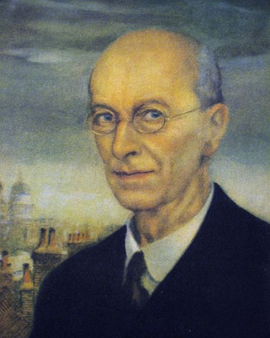It was already in the youth of the Englishman Arthur Rackham that he would one day become a great artist. But Rackham, born in London, was completely inspired to become an artist when, at the age of only 17, he made a journey to faraway Australia. He began to capture everything on his journey in drawings and watercolours. This irrepressible passion for art later made him an important illustrator of our time.
As was the case with many artists, the Rackham family was also against the artistic ambitions of the young son. Against his father's will, the gentle rebel enrolled at the Lambeth School of Art. During the day, he worked in an office in order to avoid straining his relationship with his family. He worked tirelessly on his drawings after hours. He also worked as an illustrator for newspapers, sometimes for Westminster Budget Newspaper. In his free artistic work Rackham was mainly interested in book illustrations. Here he could give free rein to his creativity.
Rackham's entry into book illustration began with a travel guide entitled To the Other Side: a guide to Canada and the United States. It was the first book he illustrated that was published. He also breathed life into the famous fairy tales of the Brothers Grimm with his drawings. Rackham's watercolors for Lewis Carroll's famous story of Alice in Wonderland were also a great success and left a lasting impression on the childhood of many generations. Illustration for fairy tales, narratives and fantasy became Rackham's beloved genre.
Its drawing style is reminiscent of Aubrey Beardsley, but is still unique and outstandingly different. His pictures are bursting with fantasy, ingenuity and attention to detail. In 1905 he established himself as the leading decorative illustrator for the Edwardian period around 1800 with his version of the American tale Rip van Winkle.
Among other things he was an illustrator for classics such as Shakespeare's A Midsummer Night's Dream, Gulliver's Travels, A Christmas Story, Cinderella, Sleeping Beauty and "The Legend of Sleepy Hollow".
Rackham was able to secure his deserved place in the history of illustration with his detailed and loving pictures.
×





.jpg)
.jpg)
.jpg)
.jpg)
.jpg)
.jpg)
.jpg)
.jpg)
.jpg)
.jpg)
.jpg)
.jpg)
.jpg)
.jpg)
.jpg)
.jpg)
.jpg)
.jpg)
_for_The_Dre_-_(MeisterDrucke-982935).jpg)
_for_The_Dre_-_(MeisterDrucke-982935).jpg)
.jpg)
.jpg)
.jpg)
.jpg)
.jpg)
.jpg)
.jpg)
.jpg)
.jpg)
.jpg)
.jpg)
.jpg)
.jpg)
.jpg)
.jpg)
.jpg)
.jpg)
.jpg)
.jpg)
.jpg)
.jpg)
.jpg)
.jpg)
.jpg)
.jpg)
.jpg)
.jpg)
.jpg)
.jpg)
.jpg)
.jpg)
.jpg)
.jpg)
.jpg)
.jpg)
.jpg)
.jpg)
.jpg)
.jpg)
.jpg)
.jpg)
.jpg)
.jpg)
.jpg)
.jpg)
.jpg)
.jpg)
.jpg)
.jpg)
.jpg)
.jpg)
.jpg)
.jpg)
.jpg)
.jpg)
.jpg)
.jpg)
.jpg)
.jpg)
.jpg)
.jpg)
.jpg)
.jpg)
.jpg)
.jpg)
.jpg)
.jpg)
.jpg)
.jpg)
.jpg)
.jpg)
.jpg)
.jpg)
.jpg)
.jpg)
.jpg)
.jpg)
.jpg)
.jpg)
.jpg)
.jpg)
.jpg)
.jpg)
.jpg)
.jpg)
.jpg)
.jpg)
.jpg)
.jpg)
.jpg)
.jpg)
.jpg)
.jpg)
.jpg)
.jpg)
.jpg)
.jpg)
.jpg)
.jpg)
.jpg)
.jpg)
.jpg)
.jpg)
.jpg)
.jpg)
.jpg)
.jpg)
.jpg)
.jpg)
.jpg)
.jpg)
.jpg)
.jpg)
.jpg)
.jpg)
.jpg)
.jpg)
.jpg)
.jpg)
.jpg)
.jpg)
.jpg)
_by_Lewis_Ca_-_(MeisterDrucke-1453393).jpg)
_by_Lewis_Ca_-_(MeisterDrucke-1453393).jpg)
.jpg)
.jpg)
.jpg)
.jpg)
.jpg)
.jpg)
.jpg)
.jpg)
.jpg)
.jpg)
.jpg)
.jpg)
.jpg)
.jpg)
.jpg)
.jpg)
.jpg)
.jpg)
.jpg)
.jpg)
.jpg)
.jpg)
.jpg)
.jpg)
.jpg)
.jpg)
.jpg)
.jpg)
.jpg)
.jpg)
.jpg)
.jpg)
.jpg)
.jpg)
.jpg)
.jpg)
.jpg)
.jpg)
.jpg)
.jpg)
.jpg)
.jpg)
.jpg)
.jpg)
.jpg)
.jpg)
.jpg)
.jpg)
.jpg)
.jpg)
_and_Balnibarbii_(main_port_Maldonada)_fr_-_(MeisterDrucke-378241).jpg)
_and_Balnibarbii_(main_port_Maldonada)_fr_-_(MeisterDrucke-378241).jpg)
.jpg)
.jpg)
.jpg)
.jpg)




